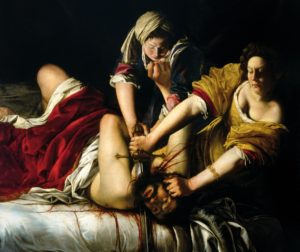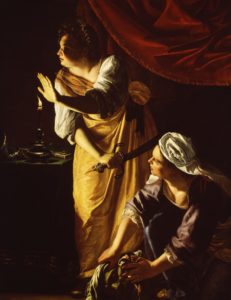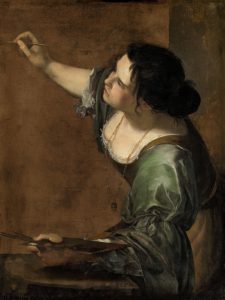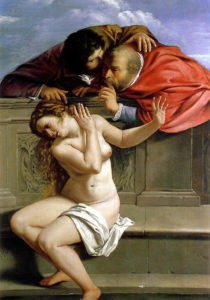Dear Artist,
A young friend, who has this fall begun an art degree, received a gut-punch crit. Up until now, due to the open-plan nature of the school’s studios and her ability to overhear the crits of her neighbours, she’d been feeling pretty good about her progress. This week, the feedback took a serious turn. She even wondered how much, perhaps, she needed to learn about painting.

Judith Slaying Holofernes, c. 1612-1613
Oil on canvas
158.8 cm × 125.5 cm
by Artemisia Gentileschi (1593 – c.1656)
Upon hearing this news, my heart both panged and doubled down. Like my Dad had with me, I’d laid low to watch her trailblaze her own experience and I spared her my prejudice. I waited to learn of her discoveries and the enrichment that would blossom from her new milieu. The crit, as it was always going to do, would merely be but a jumping off point for the hard work of reinvention, but these things rarely arrive without a reckoning. I took my bicycle out amongst the moving morning shadows and thought of how I could be of service. Here are a few ideas:
Life is school, and each period is just one semester. Find the value in this semester, however uncomfortable.
You are in school to find out what you don’t know and gather skills and experience.

Judith and her Maidservant with Head of Holofernes, c. 1623–1625
Oil on canvas
184.0 cm x 141.6 cm
by Artemisia Gentileschi
Your milieu is just that——a collection of people to draw inspiration from and to find out what you are and are not.
You are on the first page of being on a first-name basis with your materials. The breadth of technical skills and media you can explore are limited only by your curiosity.
Release your attachment to one medium.
Release your attachment to the subject matter and style you’re currently inhabiting.
Release your attachment to selling.
Resist allowing your work to be determined by conventional assumptions about the limitations of your studio space, your living situation, your bank account, the materials you think you need or the time you believe has been allotted to you.
Give yourself the gift of a blank slate.
Make as much terrible work as possible.
Your dreams, your ideas, your vision for life, your needs, your requirements, your path, your expectations and your soul are yours and yours alone, are subject to change, should be free to change and are completely your responsibility.
Sincerely,
Sara
PS: “My illustrious lordship, I’ll show you what a woman can do.” (Artemesia Gentileschi)
“Remember that all is opinion.” (Marcus Aurelius)
Esoterica: “I hate it, I hate it, I hate it, I hate it, I hate it. Erase it immediately,” said my first-year painting prof in my first crit. The painting was part of a series of work I had already sold in galleries 4000 kilometres away, in my hometown. It happened moments after I’d heard the other painting prof unleash on my neighbour, “Are you colourblind? You will fail for sure.” In the dim din of my corner cubicle, I slashed the outlaw and surrendered to a long, sunless journey. My Dad once told me that artists are often motivated by one of two feelings: “I’ll show you,” and “I love the world”——and we can fluctuate between these two realms in a matter of minutes, while alone in our rooms with our staple guns. To the best of my knowledge, this syndrome never, ever goes away——this has perhaps, something to do with accepting that we are students of life, for life. Twenty years after she hated it, my old prof, out of the blue, sent me a message after reading some news about my work online: “You made it,” she wrote. I read the message from the West Village, my heart in shambles, my stomach tight and empty but my easel still erect in the corner of my one-room, five-story walk-up, my work having transformed only a million times or so, so far. “My dream is to be an artist and to live in New York,” I whispered to myself in my solitude and failures. “I’m living my dream.”

Self-Portrait as the Allegory of Painting, 1638–39
Oil on canvas
96.5 cm × 73.7 cm
by Artemisia Gentileschi
“Squeeze your paints out like a millionaire and you’ll be one.” (Robert Genn)
Have you considered a Premium Artist Listing? With each letter, an artist is featured at the bottom of this page. The Premium Artist Listings are a means of connecting artist subscribers through their work. Proceeds from each listing contribute to the production of The Painter’s Keys.
“As long as I live I will have control over my being.” (Artemesia Gentileschi)
Featured Artist
My art represents an artistic journey that has been on-going for more than thirty-five years with help and guidance from many wonderful artists. Now, with years of plein-air painting experience, study and solo exhibitions, I believe that my current work has reached its highest level, reflecting the depth of my absorption in the wonder and beauty of the world around me. I have learned that, as an artist, I will never stop looking for better ways to express my feelings in art and that struggling to more fully understand myself is integral to my painting; a philosophy that was part of every workshop I taught. Still is.






30 Comments
“Make as much terrible work as possible.” I love it. That someone else is of that opinion validates my not having excuses for my frequent inadequacies!
After 80 years of watercolors by the thousands and a good living doing that, I have told many students that I could have easily filled my rather large studios with ruined watercolor paper. Terrible mistakes are probably one of the best learning devices.
“Make as much terrible work as possible” was my favorite, too.
just love these writings about the travails of trying to become an artist–one may well question if its even possible to become a real artist-we remain apprentices our whole life -it takes more than one lifetime I m sure to become an artist
My “best” critique was when An Entire Class refused to say One Word about my work. It put me into a crawl space at home that night.
Guess what?
I’m still working………
Beth Mahy
Oh, Sara, what a wonderful, wise column. After 40 years of making paintings and drawings, hardly a day in the studio goes by that I don’t catch a glimmer of a new possibility. Just yesterday, I was able to let go of the notion of preciousness and go for speed and boldness. I’m on my way back to the easel this morning excited for the possibilities of this new, small piece.
Thank you for your always serious, well thought out look at the implications of what we’re all trying to do.
Yep, there is no alternative, when push comes to shove…
Tenacity is a good trait to have as an artist and a bull dog with a bone.
Loved this article!
Good criticism provides suggestions that a person can act on or experiment with. Good criticism lands in the zone of curiosity – “hmm – let’s see what happens if I try that,” “wow, it really does resolve the composition if I remove that element.”
“I hate it” and “are you color blind” are not examples of critiques. They are the sputterings of people who believe they themselves have failed, who need to externalize their self hatred onto others on order to feel better.
If you get the former, cherish it. If you get the latter, use a pair of mental earplugs in the moment, and seek out real teachers elsewhere – they can even be your peers.
Agreed. I don’t know why cruelty is thought of as a useful teaching technique. Ideas, support and actual teaching of techniques goes a much longer way to helping an artist progress. How many artists have become discouraged and quit trying because of incompetent comments and instruction?
Ines says it perfectly. As a teacher I always try to find what the student has done well, then suggest there are a few ways that might improve it. Harsh critisism just destroys people.
I read this somewhere:
You have no friends, you have no enemies, you have only teachers.
This seems to be aplicable to critiques, we can choose to be offended or choose to learn.
Hear, hear! And to the instructor’s colorblind remark, I say “ Does it matter?”
Right on!!!
After expecting to be approved of, but being brutally shot down by a class of art students , the wise teacher pulled me aside during the break(down) and assured me , “There is room for everyone . “I have always remembered these words .
I taught art to young people for more than 20 years. One of the things I told them was not to “comparing themselves to others.” And, I reminded them that no one in the world could create the artwork they did; their work no matter the technical level was THEIR original piece of work. There are ways of delivering constructive criticism without demeaning the “soul” of the artist. Many of my students were not “technically talented” due to a host of factors, but are now successful artists. The key is “keeping the arts alive” within each young artist. I used to go to art seminars over many summers where I learned from a plethora of gifted artists who were school teachers. Two of the presenters said, “I gave up on my art when a teacher told me it wasn’t any good. Only years later as an adult did I pursue what I loved again and now I have my own gallery.” Often times I wondered why I kept an old Missouri license plate around (it was my grandfather’s) but I got myself saying, “You got a minute? Let me “show you” something.” I would go on to show my young people examples of art that resembled what they had done. I explained even though DeKooning looked like “something a child could do” it took hours to make an organized piece look the way it did. And if you want something bad enough, you will practice, practice, practice. And then, sometimes, your most favorite work will be the spontaneous piece where your “heART and soul” took over. I have a piece of art I created from simple sponge painting with three process colors. Over the years it has become my favorite. And before I digress, as a basketball coach, you can make or break young people. They are hinged on your every word. The key is in the delivery, but my hope is young people never give up on their dreams and many express it through art.
I expect you have been a blessing to many a young soul, artist or basketball player!
“Give yourself permission,” I told myself when I first started painting.
With only the joys and hard knocks of life as my guide, I learned that if I painted through the REALLY BAD ART there would always come a moment, a shift, a breakthrough.
There was hope.
I could go to bed at peace.
I began naming my really bad art, “the uglies”.
Note: I also discovered that looking closer and “framing” small areas of one of the “uglies”, there were sometimes elements of perfect design.
Yes! 2020 was my year for these passage paintings. Pretty awesome that even a ‘failure’ can contain gems.
Keep slinging the paint!
So, Sarah, do you think that critique by that prof so long ago helped you, or hindered you?
In my childhood years, acceptance required conformity and avoiding mistakes. It has taken decades to recognize the limitations imposed by parents, teachers, relatives, and others on my ideas, explorations, and aspirations.
These letters are so awesome that I want to paper my room with them! So thankful!
I taught drama, and I am also an artist. I had a rule in class that two good things must be pointed out before
what is lacking is addressed. I told the students that not bumping into the furniture or not being inaudible was a good thing.
I don’t wish the judge to be a hypocrite, but there are ways to be a critic. I have judged many art shows. There is always a critique. In the first place, I never say, “I like” or “I don’t like.” I had rather use the terms “works” and “needs a more work”. A lack of specificity is in no way helpful. “I see a nice use of color in your work, but I think you would do better if you edited your work and showed us where to look,” is a way to point out strong points and lacks. Why would someone wish to repeat an act that is going to bring nastiness about their work? If your ego is so lacking that you want to savage someone or their art, you don’t need to work with people. You can be truthful without being mean. I know people who have given up art for years because someone wanted to be a smart Alec and trashed their work. When you do something because you love it, you don’t need to be handed vitriol.
To live in New York as an artist was a worthy goal, Sara. Do you have a new goal? I have found we should never stop making them. If you have a goal and you focus on it everyday, something strange begins to happen, Unseen ones step in and begin placing things, (objects, people, animals etc.) in your way for you to trip over. Gentle guidance. No doubt about it an artist has the difficult job of creation throughout many failures in life. Is success how we grow? Stagnation can follow…. oops, I just tripped again…
Wow, love this letter, Sara. It is so true, we never totally graduate from that inner student of life that constantly searches for answers. I don’t know how teachers do it. To look at a young person full of dreams that they can’t reach until they learn so many things first is a precarious undertaking. One must learn technique in using the materials, learn the basic rules of what makes a successful composition. We must learn and understand so many things first, but “think” we already know those things because we have proven a few successes that say we have artistic talent, I remember being so dumb. I also recall my beginning years filled with words that did discourage me, but here I am still painting every day, so perhaps I am one of those “well, I’ll show you” students. What makes a good teacher is a human being with great empathy. Feeling criticism from someone who looks further into the student struggling away is not discouraging. It is a special attribute many don’t own in their make up. It speaks on it’s own and carries the lessons with us for the rest of our life. I look back at my many classes days and only a few stand out as encouraging teachers and mentors. And I am thankful for all of you. :)
I welcome criticism. But I confess what really hurts is to see another artist receive lots of praise and then SELL work that looks a lot like something I did that was harshly criticized by a teacher. After abandoning a certain direction because I’ve been told it was all wrong, to then see it praised and rewarded in another person’s work is very disorienting. I no longer feel I can trust my own judgment!
I go back to my own work, avoid assessment for a while, and try to regain faith in what I’m trying to do.
To quote Richard Diebenkorn “you’ve got to make a lot of bad paintings”.
I loved this post. I recently read a quote that stuck with me. “Criticism is like pain, if it doesn’t hurt enough, you won’t remember it. There may be truth in this.
I was very lucky to have as my only teacher a man that was always making me feel good by pointing out the good stuff and then would proceed to help me understand the problems. It wasn’t till later in life that I understood what he actually did.
sorry I am going to break the mould. I did not like “make as much terrible work as possible”. If you allow yourself, or anyone else, to criticise your work in this way, how will you build confidence?
The fact is….. Any work you produce is unlikely to meet your expectations in the early days of learning, but that does not mean it is TERRIBLE. I bleive you MUST Practice as much as you can, make the time for practice even if your expectations are not being met, because EVERY PIECE OF WORK WILL CONTAIN A NUGGET OF LEARNING, EVEN IF YOU DO NOT RECOGNISE IT IMMEDIATELY.” I really, really dislike the idea that any work can be “terrible” and feel it is a horrible phrase to use. Every piece of work is another groove in the record you are making…it will be something you can learn from, it will have exercised muscles you did not even know you had, and it will have taught you what you would prefer NOT to do next time….so it is a step on the ladder of growth and learning. PLEASE PLEASE IGNORE THIS PIECE OF DREADFULLY-WORDED ADVICE.
I’m not sure who said it, but the one comment I keep in mind, after all these years, is that whatever I’m saying with my work is mine alone – it will never be said in the same way by anyone else, ever. And that, in and of itself, is of value.